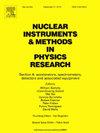ATLAS ITk带状模块中的新型应力消除层
IF 1.4
3区 物理与天体物理
Q3 INSTRUMENTS & INSTRUMENTATION
Nuclear Instruments & Methods in Physics Research Section A-accelerators Spectrometers Detectors and Associated Equipment
Pub Date : 2025-07-30
DOI:10.1016/j.nima.2025.170896
引用次数: 0
摘要
ATLAS实验的内部探测器系统将被一个新的全硅探测器所取代,称为内部跟踪器(ITk),为高亮度LHC的高粒子速率条件做准备。ITk的最内层将由硅像素组成,而外层将由硅条组成。ITk条带检测器的基本元件是模块,由前端电子元件粘在硅微带传感器上组成。在模块预生产过程中遇到了一个关键问题,即一些硅传感器在安装到局部支撑结构上并在低温下工作时,由于热应力而破裂。一种可能的解决方案是对模块进行重新设计,在前端电子设备和硅传感器之间添加一层新的软胶,以吸收热应力。这种重新设计需要项目的一个新的研发阶段。这些程序探讨了将应力消除层纳入模块组装链的技术挑战,并评估了重新设计对原型模块性能的影响。本文章由计算机程序翻译,如有差异,请以英文原文为准。
A new stress-relieving layer in ATLAS ITk strip modules
The Inner Detector system of the ATLAS experiment will be replaced with a new all-silicon detector known as the Inner Tracker (ITk) to prepare for high particle-rate conditions at the High Luminosity LHC. The innermost layers of the ITk will be composed of silicon pixels, while the outer layers will consist of silicon strips. The basic element of the ITk Strip detector is the module, composed of front-end electronics glued to a silicon microstrip sensor. A critical problem was encountered during module pre-production wherein some silicon sensors cracked due to thermal stresses when mounted to local support structures and brought to cold operating temperatures. A potential solution has been trialed in which the modules are redesigned to include a new layer of soft glue between the front-end electronics and the silicon sensor to absorb thermal stresses. This redesign necessitated a new R&D phase of the project. These proceedings explore the technical challenges of incorporating the stress-relieving layer into the module assembly chain and evaluate the impact of the redesign on prototype module performance.
求助全文
通过发布文献求助,成功后即可免费获取论文全文。
去求助
来源期刊
CiteScore
3.20
自引率
21.40%
发文量
787
审稿时长
1 months
期刊介绍:
Section A of Nuclear Instruments and Methods in Physics Research publishes papers on design, manufacturing and performance of scientific instruments with an emphasis on large scale facilities. This includes the development of particle accelerators, ion sources, beam transport systems and target arrangements as well as the use of secondary phenomena such as synchrotron radiation and free electron lasers. It also includes all types of instrumentation for the detection and spectrometry of radiations from high energy processes and nuclear decays, as well as instrumentation for experiments at nuclear reactors. Specialized electronics for nuclear and other types of spectrometry as well as computerization of measurements and control systems in this area also find their place in the A section.
Theoretical as well as experimental papers are accepted.

 求助内容:
求助内容: 应助结果提醒方式:
应助结果提醒方式:


